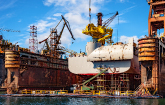Global Marine Trends 2030 Report Predicts Naval Sector Growth
FARNBOROUGH, England, April 8, 2013 /PRNewswire/ --
Research Reveals Sharp Rise In Use of Systems in Advanced Navies
Despite an uncertain short term future for the maritime industry, the Global Marine Trends 2030 (GMT 2030) report launched today predicts that long term growth will return. Written and researched jointly by Lloyd's Register, QinetiQ and Strathclyde University, the report looks at the future shape of the marine industry and specifically how naval power will increase.
Recent reports from UNCTAD* and the Rogliano** review conclude that the industry is currently going through one of its worst crises for decades. According to these reports, as ship owners continue to increase tonnage from pre-recession orders for ships, seaborne trade growth is failing to grow apace, leading to an excess in supply over demand.
This has led to predictions that the financial future of the industry could lead to some significant casualties with established names being at risk.*** This is compounded at a time when many advanced navies are suffering from short term Government budget cuts, affecting their ability to invest in capital acquisitions, or maintain fleets at sea.
However, the GMT 2030 report suggests that 'the marine world in 2030 will be almost unrecognisable owing to the rise of emerging countries, new consumer classes and resource demand'. The report predicts that as trade increases, the size of fleets for advanced navies (US, Russia, Japan, China, UK, India) will continue to fall from 585 major platforms in 2010 to 500 in 2030. However, the naval power exercised by these navies through technology, will almost double from 3,911 in 2010 to 8,526 in 2030, based upon QinetiQ's Naval Power Index.****
Sarah Kenny, Managing Director QinetiQ Maritime commented, "This is an important piece of research which establishes what the future may look like. Having worked with navies from around the world for many years, we have a long heritage of expertise that helps us give a unique insight into the marine and naval industry. With naval platforms having an operational lifespan of at least 25 years, research such as this helps us plan for 2020, 2030 and the next generation of naval capability. Accurate thinking about expected operations will have a substantial impact on the through-life cost of the platform. As international trade continues to grow, the need for naval power will also continue to increase, because the vast majority of trade is moved by sea. We expectthe use of that power may change and that systems such as robotics and autonomous systems will dominate thinking."
The 'Global Marine Trends 2030' Report was launched today at events in London and Singapore by the joint team from Lloyd's Register, QinetiQ and Strathclyde University. The Report is a long term view of trends in the marine world, and will be of particular interest to the most significant economic users of the seas - commercial shipping, navies, and offshore energy producers. It is based on assessing and modelling key global drivers (Population, Economy, Resources and Environment) in order to show their direction and speed and their combined effect on maritime developments.
The GMT 2030 report used three scenarios of international politics to model the future. These scenarios, using three key drivers - population growth, economic development and demand for resources - describe what maritime trade, sea power and the offshore energy sectors could look like in 2030. The three scenarios were:
- Status Quo - the world will continue its current growth momentum with booms and busts over the next 20 years
- Global Commons -the world will wake up to dangers such as global warming and diminishing resources. This will lead to governments working together and trading more to provide accelerated economic growth within a framework of sustainable development
- Competing Nations - states will act in their own national interest. There will be little effort to forge agreement amongst governments for sustainable development and international norms. This is a self-interest and zero-sum world with a likely rise in protectionism and slower economic growth.
The report predicts that Naval power will almost double in all of the three scenarios.
For more information on the report visit http://www.QinetiQ.com/maritime/GMT2030
Notes for Editors:
* http://unctad.org/en/pages/PublicationWebflyer.aspx?publicationid=380
** http://www.brs-paris.com/marketbrs/annual-2013-a.php
*** http://dealbook.nytimes.com/2013/03/22/shipping-woes-may-weigh-on-european-banks/
**** The Naval Power Index looks at the number of platforms in a given type, representative crew size and system capability, and the primary weapons' range, warhead mass and numbers and is 97% correlated to GDP. It enables users to objectively link the economic drivers with subjective issues like politics and demographics to suggest the scale of Naval powers in 2030.
About QinetiQ
- A FTSE250 company, QinetiQ uses its domain knowledge to provide technical support and know-how to customers in the global aerospace, defence and security markets. QinetiQ's unique position enables it to be a trusted partner to government organisations, predominantly in the UK and the US, including defence departments, intelligence services and security agencies.
- Follow us on twitter @QinetiQ
- Visit QinetiQ at DSEi at ExCeL in London between 10th - 13th September 2013. The world's leading defence and security event.
Visit the website at http://www.QinetiQ.com
SOURCE QinetiQ
WANT YOUR COMPANY'S NEWS FEATURED ON PRNEWSWIRE.COM?
Newsrooms &
Influencers
Digital Media
Outlets
Journalists
Opted In





Share this article